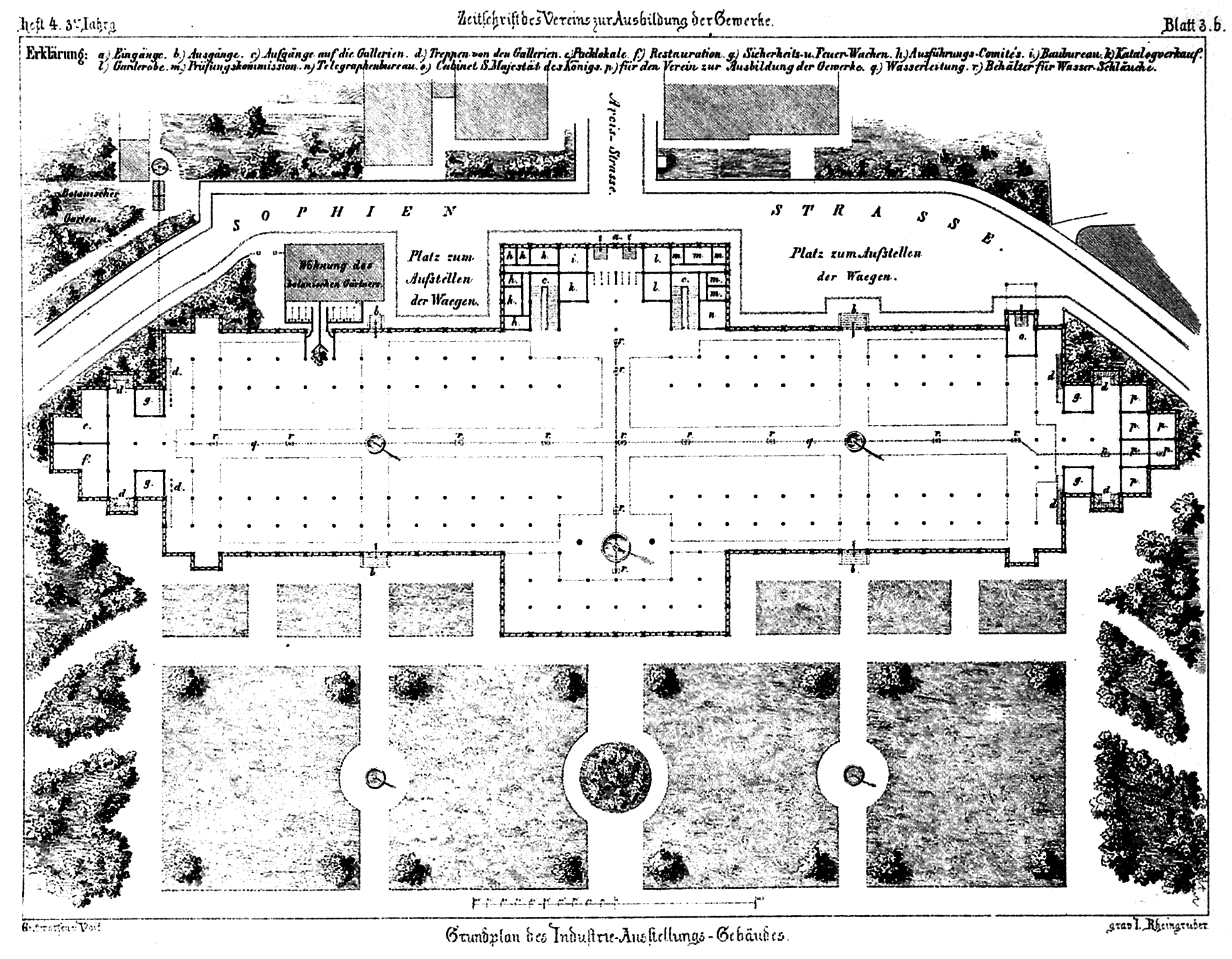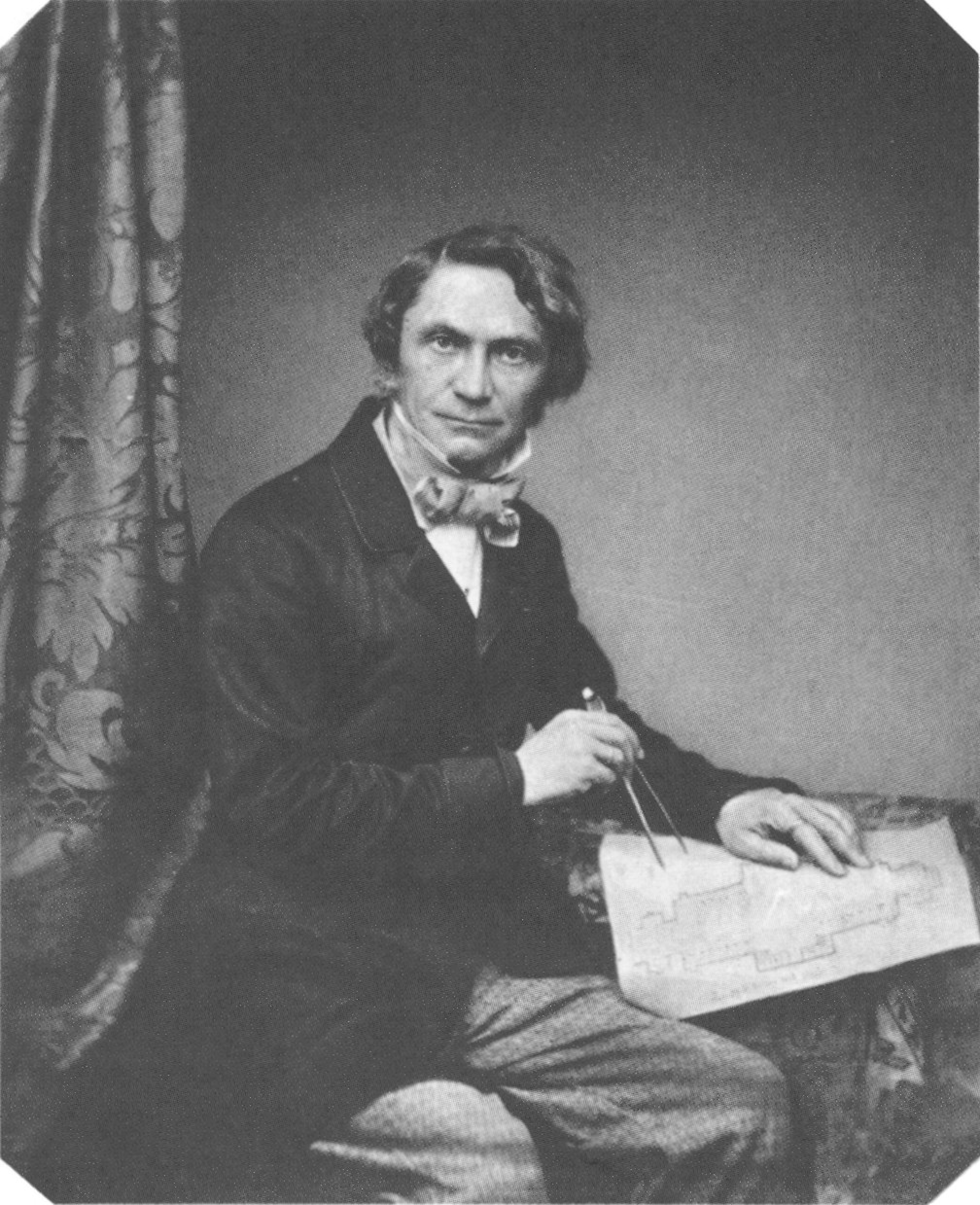|
General German Industrial Exhibition
The General German Industrial Exhibition was designed to demonstrate German industry to a global audience, but was adversely impacted by a cholera epidemic. It ran from 15 July 1854 until 15 October. There more than 5,000 visitors a day with more than 90,000 visitors on the first day. Building The building, the Glaspalast, followed the architecture of The Crystal Palace three years earlier in London. It was made of glass and cast iron, over two levels inspired. It had two stories and over of floor area, and was tall. Cholera There had been global cases of cholera (the third cholera pandemic before the festival, but the risk of it was downplayed and the exhibition and a concurrent festival still took place. By August the epidemic hit Munich, 3,000 people eventually died of cholera and some contracting it at the exhibition including a woman from Thaining Thaining is a municipality in the district of Landsberg in Bavaria in Germany Germany,, officially the Feder ... [...More Info...] [...Related Items...] OR: [Wikipedia] [Google] [Baidu] |
Glaspalast (Munich)
The ''Glaspalast'' (Glass Palace) was a glass and iron exhibition building located in the Old botanical garden - Munich in Munich modeled after The Crystal Palace in London. The Glaspalast opened for the first General German Industrial Exhibition on July 15, 1854. Planning Following other examples around Europe, the ''Glaspalast'' was ordered by Maximilian II, King of Bavaria, in order to hold the ''Erste Allgemeine Deutsche Industrieausstellung'' (First General German Industrial Exhibition) on July 15, 1854. Originally it was planned to erect the building on Maximilianplatz. However, the relevant Commission decision preferred an area near the railway station. Designed by architect August von Voit and built by MAN AG, the building was built in 1854 to the north of the Old Botanical Garden close to the Stachus. Construction Following the completion of 1853 Schrannenhalle and the planned and conservatory of Munich Residence, a glass with cast iron design was used, using exi ... [...More Info...] [...Related Items...] OR: [Wikipedia] [Google] [Baidu] |
Maximilian II, King Of Bavaria
Maximilian II (28 November 1811 – 10 March 1864) reigned as King of Bavaria between 1848 and 1864. Unlike his father, King Ludwig I, "King Max" was very popular and took a greater interest in the business of Government than in personal extravagance. Ascending the throne during the German Revolution of 1848, King Maximilian restored stability in his kingdom. The rest of his reign was characterized by attempts to maintain Bavarian independence during the wars of German Unification and to transform his capital city of Munich into a cultural and educational city. Crown Prince He was born in Munich and was the eldest son of the Crown Prince of Bavaria (later King Ludwig I) and his wife Therese of Saxe-Hildburghausen. After studying at Göttingen and Berlin and travelling in Germany, Italy and Greece, he was introduced by his father into the council of state (1836). From the first he showed a studious disposition, declaring on one occasion that had he not been born in a royal cr ... [...More Info...] [...Related Items...] OR: [Wikipedia] [Google] [Baidu] |
August Von Voit
Richard Jakob August von Voit (17 February 1801 in Wassertrüdingen – 12 December 1870 in Munich) was a German architect specializing in glass and iron structures. Notable projects Voit designed the city hall of Annweiler am Trifels ( Rhineland-Palatinate) and the in Rhineland-Palatinate. He also designed two synagogues, one in Kirchheimbolanden in 1834, and another in Speyer in 1837. Von Voit also created the neo-Romanesque facade on St. Anna's, Lehel, which was destroyed during the war. 1846–1853 – Neue Pinakothek The Neue Pinakothek Art Museum was commissioned by Ludwig I of Bavaria and designed by Von Voit and Friedrich von Gärtner. The design of the structure was calculated to reinforce the similarity between the older and newer museums. As part of the design, Von Voit commissioned Wilhelm von Kaulbach to show the achievements of German art in mural form. The building as originally designed was demolished in 1950 and rebuilt in 1967. 1853–1854 – Glas ... [...More Info...] [...Related Items...] OR: [Wikipedia] [Google] [Baidu] |
Kingdom Of Bavaria
The Kingdom of Bavaria (german: Königreich Bayern; ; spelled ''Baiern'' until 1825) was a German state that succeeded the former Electorate of Bavaria in 1805 and continued to exist until 1918. With the unification of Germany into the German Empire in 1871, the kingdom became a federated state of the new empire and was second in size, power, and wealth only to the leading state, the Kingdom of Prussia. The polity's foundation dates back to the ascension of prince-elector Maximilian IV Joseph of the House of Wittelsbach as King of Bavaria in 1805. The crown would go on being held by the Wittelsbachs until the kingdom came to an end in 1918. Most of the border of modern Germany's Free State of Bavaria were established after 1814 with the Treaty of Paris, in which the Kingdom of Bavaria ceded Tyrol and Vorarlberg to the Austrian Empire while receiving Aschaffenburg and Würzburg. In 1918, Bavaria became a republic after the German Revolution, and the kingdom was thus succeeded ... [...More Info...] [...Related Items...] OR: [Wikipedia] [Google] [Baidu] |
Munich
Munich ( ; german: München ; bar, Minga ) is the capital and most populous city of the States of Germany, German state of Bavaria. With a population of 1,558,395 inhabitants as of 31 July 2020, it is the List of cities in Germany by population, third-largest city in Germany, after Berlin and Hamburg, and thus the largest which does not constitute its own state, as well as the List of cities in the European Union by population within city limits, 11th-largest city in the European Union. The Munich Metropolitan Region, city's metropolitan region is home to 6 million people. Straddling the banks of the River Isar (a tributary of the Danube) north of the Northern Limestone Alps, Bavarian Alps, Munich is the seat of the Bavarian Regierungsbezirk, administrative region of Upper Bavaria, while being the population density, most densely populated municipality in Germany (4,500 people per km2). Munich is the second-largest city in the Bavarian dialects, Bavarian dialect area, ... [...More Info...] [...Related Items...] OR: [Wikipedia] [Google] [Baidu] |
The Crystal Palace
The Crystal Palace was a cast iron and plate glass structure, originally built in Hyde Park, London, Hyde Park, London, to house the Great Exhibition of 1851. The exhibition took place from 1 May to 15 October 1851, and more than 14,000 exhibitors from around the world gathered in its exhibition space to display examples of technology developed in the Industrial Revolution. Designed by Joseph Paxton, the Great Exhibition building was long, with an interior height of , and was three times the size of St Paul's Cathedral. The introduction of the sheet glass method into Britain by Chance Brothers in 1832 made possible the production of large sheets of cheap but strong glass, and its use in the Crystal Palace created a structure with the greatest area of glass ever seen in a building. It astonished visitors with its clear walls and ceilings that did not require interior lights. It has been suggested that the name of the building resulted from a piece penned by the playwright Doug ... [...More Info...] [...Related Items...] OR: [Wikipedia] [Google] [Baidu] |
Third Cholera Pandemic
Third or 3rd may refer to: Numbers * 3rd, the ordinal form of the cardinal number 3 * , a fraction of one third * 1⁄60 of a ''second'', or 1⁄3600 of a ''minute'' Places * 3rd Street (other) * Third Avenue (other) * Highway 3 Music Music theory *Interval number of three in a musical interval **major third, a third spanning four semitones **minor third, a third encompassing three half steps, or semitones **neutral third, wider than a minor third but narrower than a major third **augmented third, an interval of five semitones **diminished third, produced by narrowing a minor third by a chromatic semitone *Third (chord), chord member a third above the root *Degree (music), three away from tonic **mediant, third degree of the diatonic scale **submediant, sixth degree of the diatonic scale – three steps below the tonic **chromatic mediant, chromatic relationship by thirds *Ladder of thirds, similar to the circle of fifths Albums *''Third/Sister Lovers'', a ... [...More Info...] [...Related Items...] OR: [Wikipedia] [Google] [Baidu] |
Thaining
Thaining is a municipality in the district of Landsberg in Bavaria in Germany Germany,, officially the Federal Republic of Germany, is a country in Central Europe. It is the second most populous country in Europe after Russia, and the most populous member state of the European Union. Germany is situated betwe .... References Landsberg (district) {{Landsberg-geo-stub ... [...More Info...] [...Related Items...] OR: [Wikipedia] [Google] [Baidu] |
Haidhausen (Munich)
Haidhausen (Central Bavarian: ''Haidhausn'') is a quarter of Munich, Germany. It is now part of the borough—or stadtbezirk—number 5 Au-Haidhausen. Location Haidhausen is bordered to the north by Bogenhausen, Berg am Laim to the east, to the south by Au, and the west border of the district is delimited by the Isar river. The boundary of the zone runs north along the Prinzregentenstraße avenue then west of the square Vogelweideplatz between the civic amenity site and the tram depot on the railway track which forms the eastern border, where the entire track is still part of Haidhausen. In the south the Rosenheimer, Hoch, Rabl and Balanstraße streets form the border with Au. To the west there are the right banks of the Isar river. History Haidhausen was first mentioned in the year 808 under the name of ''haidhusir'' described in the documents as a settlement of small houses and a church. From Munich you can reach it via the "gaachen Steig" (very steep path), which ... [...More Info...] [...Related Items...] OR: [Wikipedia] [Google] [Baidu] |
1854 Establishments In Bavaria
Events January–March * January 4 – The McDonald Islands are discovered by Captain William McDonald aboard the ''Samarang''. * January 6 – The fictional detective Sherlock Holmes is perhaps born. * January 9 – The Teutonia Männerchor in Pittsburgh, U.S.A. is founded to promote German culture. * January 20 – The North Carolina General Assembly in the United States charters the Atlantic and North Carolina Railroad, to run from Goldsboro through New Bern, to the newly created seaport of Morehead City, near Beaufort. * January 21 – The iron clipper runs aground off the east coast of Ireland, on her maiden voyage out of Liverpool, bound for Australia, with the loss of at least 300 out of 650 on board. * February 11 – Major streets are lit by coal gas for the first time by the San Francisco Gas Company; 86 such lamps are turned on this evening in San Francisco, California. * February 13 – Mexican troops force William Walker and his ... [...More Info...] [...Related Items...] OR: [Wikipedia] [Google] [Baidu] |


